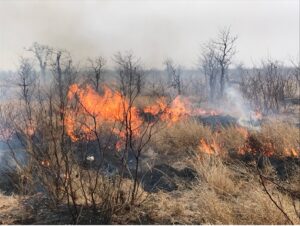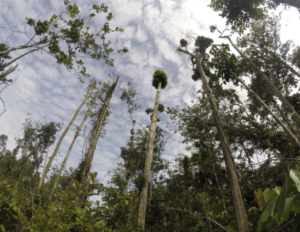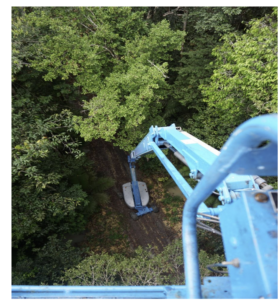Simulated feedback between fire behavior and vegetation traits drive emergent patterns.

Image courtesy of Jacquelyn K. Shuman, NASA Ames Research Center Fire is an essential component of many ecosystems, shaping the distribution of trees and grasses. Managed fire, shown implemented in South Africa’s Kruger National Park, can be used to understand fuel moisture thresholds and fire behavior and effects.
The Science
Frequent fire can prevent trees from growing in drier regions of the tropics. In wet tropical forests, fire is infrequent and low intensity. Researchers adapted a model of fire behavior for use with a model of vegetation dynamics to capture this interaction between fire and trees in predictions of tropical ecosystems across climate gradients. The predictions captured the gradient from high to low biomass along with a transition from wet tropical forest to drier savanna and grassland across South America. This new modeling capability is essential to predicting how Amazon forest could change under future drier conditions.
The Impact
The dynamic interaction between fire and vegetation is not well represented in most global model predictions of the future climate and biosphere. Yet it is expected to be important to both. This work demonstrates an important new modeling capability that expands the potential applications for the Functionally Assembled Terrestrial Ecosystem Simulator (FATES), a vanguard vegetation model supported by the DOE. The model captures the feedback and interactions between fire, changing fuels, surviving tree canopies and local conditions, and can be used to project where tropical trees and grasses are likely to survive under future climate and fuel conditions.
Summary
To accurately project changes in fire and its impacts requires fire-vegetation models that integrate plant properties that affect fire behaviors and the response of vegetation distribution and structure to fire. We adapted the fire behavior and effects module, Spread and Intensity of Fire (SPITFIRE), for use with the Functionally Assembled Terrestrial Ecosystem Simulator (FATES), a size-structured vegetation demographic model, and tested model predictions of tropical forest and grassland biogeography. In the simulations, three types of vegetation competed for resources: a fire-vulnerable tree, a fire-tolerant tree, and a fire-promoting grass. We found the model sensitive to a parameter governing fuel moisture, with drier fuels expanding grass, fire-tolerant trees, and fire-burned area. Fire mortality was elevated for small and fire-vulnerable trees, as in observations. The model captured productivity and spatial biomass patterns in fire-disturbed forests, but was biased in less disturbed areas. Although burned fraction was predicted as greater than observed in grass-dominated areas, biogeography of fire-tolerant and fire-vulnerable trees corresponded to observations across the tropics. The results reflect a positive grass–fire feedback and suggest that infrequent-fire forests may be vulnerable to higher fire intensities. With SPITFIRE, FATES is useful for assessing the vulnerability and resilience of tropical forests to fire.
Contact
Jacquelyn Shuman
NASA Ames Research Center
jacquelyn.k.shuman@nasa.gov, 303-319-1509
Funding
This esearch was supported as part of the Next Generation Ecosystem Experiments-Tropics (NGEE-Tropics), funded by the U.S. Department of Energy, Office of Science.
Publications
J.K. Shuman, et al. “Dynamic ecosystem assembly and escaping the “fire-trap” in the tropics: Insights from FATES_15.0.0.” Geoscientific Model Development 17, 4643–4671 (2024) [DOI: 10.5194/gmd-17-4643-2024]




